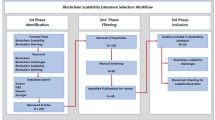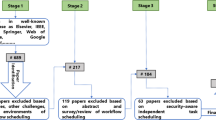Abstract
In cloud–fog environments, the opportunity to avoid using the upstream communication channel from the clients to the cloud server all the time is possible by fluctuating the conventional concurrency control protocols. Through the present paper, the researcher aimed to introduce a new variant of the optimistic concurrency control protocol. Through the deployment of augmented partial validation protocol, IoT transactions that are read-only can be processed at the fog node locally. For final validation, update transactions are the only ones sent to the cloud. Moreover, the update transactions go through partial validation at the fog node which makes them more opportunist to commit at the cloud. This protocol reduces communication and computation at the cloud as much as possible while supporting scalability of the transactional services needed by the applications running in such environments. Based on numerical studies, the researcher assessed the partial validation procedure under three concurrency protocols. The study’s results indicate that employing the proposed mechanism shall generate benefits for IoT users. These benefits are obtained from transactional services. We evaluated the effect of deployment the partial validation at the fog node for the three concurrency protocols, namely AOCCRBSC, AOCCRB and STUBcast. We performed a set of intensive experiments to compare the three protocols with and without such deployment. The result reported a reduction in miss rate, restart rate and communication delay in all of them. The researcher found that the proposed mechanism reduces the communication delay significantly. They found that the proposed mechanism shall enable low-latency fog computing services of the IoT applications that are a delay sensitive.


















Similar content being viewed by others
References
Abbas Q, Shafiq H, Ahmad I, Tharanidharan S (2016) Concurrency control in distributed database system. In: 2016 International conference on computer communication and informatics (ICCCI), 7–9 Jan 2016, pp 1–4. https://doi.org/10.1109/iccci.2016.7479987
Al-Qerem A, Hamarsheh A, Al-lahham YA, Eleyat M (2018) Scheduling of concurrent transactions in broadcasting environment. KSII Trans Internet Inf Syst (TIIS) 12:1655–1673
Baccarelli E, Naranjo PGV, Scarpiniti M, Shojafar M, Abawajy JH (2017) Fog of everything: energy-efficient networked computing architectures, research challenges, and a case study. IEEE Access 5:9882–9910
Baidya S, Levorato M (2017) Edge-assisted content and computation-driven dynamic network selection for real-time services in the urban IoT. In: 2017 IEEE conference on computer communications workshops (INFOCOM WKSHPS), 1–4 May 2017, pp 796–801. https://doi.org/10.1109/infcomw.2017.8116478
Bonomi F, Milito R, Zhu J, Addepalli S (2012) Fog computing and its role in the internet of things. In: Proceedings of the first edition of the MCC workshop on mobile cloud computing, 2012. ACM, pp 13–16
Dragojevi A et al (2015) No compromises: distributed transactions with consistency, availability, and performance. In: Paper presented at the proceedings of the 25th symposium on operating systems principles, Monterey, California
Ejaz W, Naeem M, Shahid A, Anpalagan A, Jo M (2017) Efficient energy management for the internet of things in smart cities. IEEE Commun Mag 55:84–91
Fraga-Lamas P, Fernández-Caramés T, Suárez-Albela M, Castedo L, González-López M (2016) A review on internet of things for defense and public safety Sensors 16:1644
Gessert F, Bücklers F, Ritter N (2014) Orestes: a scalable database-as-a-service architecture for low latency. In: 2014 IEEE 30th international conference on data engineering workshops, 31 March–4 April 2014, pp 215–222. https://doi.org/10.1109/icdew.2014.6818329
Gupta H, Vahid Dastjerdi A, Ghosh SK, Buyya R (2017) iFogSim: a toolkit for modeling and simulation of resource management techniques in the Internet of Things, edge and fog computing environments. Softw Pract Exp 47:1275–1296. https://doi.org/10.1002/spe.2509
Harrington JL (2016) Chapter 22—concurrency control. In: Harrington JL (ed) Relational database design and implementation, 4th edn. Morgan Kaufmann, Boston, pp 449–470. https://doi.org/10.1016/B978-0-12-804399-8.00022-3
Hasan MS, Alvares F, Ledoux T, Pazat J-L (2017) Investigating energy consumption and performance trade-off for interactive cloud application. IEEE Trans Sustain Comput 2:113–126
Huang Y, Lee Y-H (2001) STUBcast-efficient support for concurrency control in broadcast-based asymmetric communication environment. In: Proceedings tenth international conference on computer communications and networks (Cat. No. 01EX495), 2001. IEEE, pp 262–267
Jung S, Choi K (2009) A concurrency control scheme for mobile transactions in broadcast disk environments. Data Knowl Eng 68:926–945
Kaur N, Sood SK (2017) An energy-efficient architecture for the Internet of Things (IoT). IEEE Syst J 11:796–805
Kliazovich D, Pecero JE, Tchernykh A, Bouvry P, Khan SU, Zomaya AY (2013) CA-DAG: communication-aware directed acyclic graphs for modeling cloud computing applications. In: 2013 IEEE sixth international conference on cloud computing, 28 June–3 July 2013, pp 277–284. https://doi.org/10.1109/cloud.2013.40
Markakis EK et al (2017) EXEGESIS: extreme edge resource harvesting for a virtualized fog environment. IEEE Commun Mag 55:173–179
Md. Anisur Rahman D (2013) An efficient concurrency control technique for mobile database environment global. J Comput Sci Technol 13(2-C):17–21
Park S, Jung S (2009) An energy-efficient mobile transaction processing method using random back-off in wireless broadcast environments. J Syst Softw 82:2012–2022
Peralta G, Iglesias-Urkia M, Barcelo M, Gomez R, Moran A, Bilbao J (2017) Fog computing based efficient IoT scheme for the Industry 4.0. In: 2017 IEEE international workshop of electronics, control, measurement, signals and their application to mechatronics (ECMSM), 2017. IEEE, pp 1–6
Suh Y-K, Snodgrass RT, Currim S (2017) An empirical study of transaction throughput thrashing across multiple relational DBMSes. Inf Syst 66:119–136
Acknowledgements
I would like to express my gratitude to Zarqa university for granting me a sabbatical leave at Princess Sumaya University for Technology for the academic year 2018–2019. Funding was provided by Zarqa University.
Author information
Authors and Affiliations
Corresponding author
Ethics declarations
Conflict of interest
The authors declare that they have no conflict of interest.
Ethical approval
This article does not contain any studies with human participants or animals performed by any of the authors.
Additional information
Communicated by B. B. Gupta.
Publisher’s Note
Springer Nature remains neutral with regard to jurisdictional claims in published maps and institutional affiliations.
Rights and permissions
About this article
Cite this article
Al-Qerem, A., Alauthman, M., Almomani, A. et al. IoT transaction processing through cooperative concurrency control on fog–cloud computing environment. Soft Comput 24, 5695–5711 (2020). https://doi.org/10.1007/s00500-019-04220-y
Published:
Issue Date:
DOI: https://doi.org/10.1007/s00500-019-04220-y




